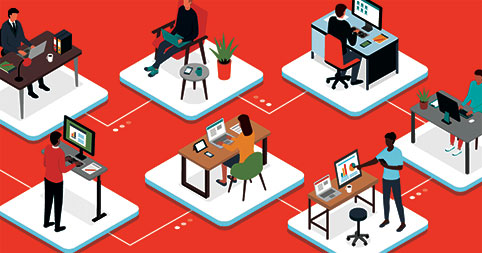
Introduction
In recent years, the realm of work has undergone a profound metamorphosis, providing both employees and employers with a pivotal juncture. The traditional brick-and-mortar office, once the exclusive hub of work, is no longer the solitary option on the horizon. This transformation has been propelled by an amalgamation of technological advancements, shifting attitudes towards work-life equilibrium, and the formidable trials posed by the COVID-19 pandemic. Consequently, the debate revolving around remote and in-office work persists in its intensity.
In the ensuing discourse, we will embark on a thorough exploration of the dynamic terrain that characterizes the evolving workplace. Our expedition entails an exhaustive analysis of the pros and cons associated with both remote and in-office work. We will closely examine the cascading repercussions of these changes on individual employees, the organizations they serve, and the broader economic landscape. Our objective is to dissect the nuances inherent in the remote versus in-office work discourse, shedding light on invaluable insights for individuals and entities as they navigate this new work landscape.

The Surge of Remote Work
Remote work, often denoted as telecommuting, has witnessed a meteoric ascent in popularity in recent times. Several pivotal factors have propelled it into the spotlight:
- Technological Advancements: The widespread proliferation of high-speed internet, advanced collaboration tools, and the advent of cloud computing have democratized remote work, enabling employees to execute their duties from virtually any location armed with an internet connection.
- Changing Mindsets: There has been a noticeable shift in employee preferences, with an increasing number gravitating towards the allure of flexibility and an improved work-life balance. Many now covet the autonomy that remote work bestows.
- COVID-19 Pandemic: The onset of the pandemic catapulted remote work into the mainstream as businesses scrambled to adapt to lockdowns and social distancing measures.
- Global Talent Pool: Remote work facilitates the engagement of a diverse and geographically dispersed talent pool. Companies can now tap into this expansive reservoir to secure top-notch talent, irrespective of their physical whereabouts.
The Merits of Remote Work
Remote work boasts several persuasive advantages:
- Flexibility: Remote work empowers employees to fashion their own schedules, granting them the latitude to harmonize their professional obligations with personal and familial responsibilities. This often translates into heightened job satisfaction and an overall improved sense of well-being.
- Cost Savings: Both employees and employers stand to reap financial savings. Employees can curtail expenses associated with commuting, work attire, and dining out, while employers can trim costs linked to office space and utilities.
- Heightened Productivity: Certain studies have indicated that remote workers tend to be more productive. The absence of distracting office elements and the ability to tailor their work environment to their liking are frequently cited as contributing factors.
- Access to Diverse Talent: Remote work simplifies the recruitment of top-tier talent regardless of their geographical coordinates, culminating in a more diversified and skilled workforce.
- Environmental Benefits: Reduced commuting translates to diminished greenhouse gas emissions, a pivotal stride towards environmental sustainability.

The drawbacks of remote work
Nevertheless, remote work comes with its own set of challenges.
- Isolation and Loneliness: The remote work setting can be isolating, fostering feelings of solitude and disconnection from colleagues.
- Communication Hurdles: Effective communication and collaboration can be impeded in a remote setting, often resulting in misunderstandings and project delays.
- Performance Monitoring Complexity: Employers may grapple with the complexity of monitoring the performance of remote employees, potentially giving rise to accountability issues.
- Blurred Work-Life Boundaries: The absence of a clear demarcation between work and personal life can pose difficulties for remote workers in detaching themselves from their professional responsibilities.
- Inequities: Remote work is not universally accessible, potentially engendering disparities within organizations.
Advocating the In-Office Model
While remote work offers significant benefits, the traditional in-office model retains its value.
- Face-to-Face Interaction: In-office work cultivates face-to-face communication, fostering robust relationships, bolstering collaboration, and nurturing a sense of camaraderie among colleagues.
- Nurturing Creativity and Innovation: Physical office spaces can be meticulously designed to stimulate creativity and innovation. They offer collaborative environments and dedicated brainstorming areas.
- Management and Mentoring: In-office work facilitates more effective supervision, mentoring, and on-the-job training, particularly for junior employees.
- Preserving Company Culture: A physical office serves as the crucible wherein a company’s culture, values, and identity are forged and reinforced.
- Security and Compliance: Certain industries and roles mandate stringent security measures and compliance standards, which are more readily enforceable within the precincts of an office.

The Limitations of In-Office Work
However, in-office work is not without its shortcomings.
- Commute and Traffic: The daily commute associated with in-office work can induce stress, consume precious time, and contribute to environmental concerns.
- Limited Flexibility: In-office employees often have less control over their schedules, posing a challenge for those juggling family or personal obligations.
- Overhead Costs: Employers bear the burden of maintaining office spaces, utilities, and amenities.
- Impact on Health and Well-Being: Extended hours spent within an office environment can contribute to sedentary lifestyles and various health issues.
- Geographical Constraints: In-office work confines hiring options to individuals residing within or willing to relocate to the company’s geographical vicinity.
The Emergence of Hybrid Work Models
Recognizing the strengths and weaknesses of both remote and in-office work, numerous organizations are embracing hybrid work models. These models empower employees to apportion their time between remote and in-office work, striking a harmonious equilibrium that extracts the best from both paradigms.
Key tenets of flourishing hybrid work models encompass:
- Transparent Communication: Employers must institute clear guidelines and expectations, elucidating when employees are expected to be physically present in the office and when they can operate remotely.
- Flexibility in Scheduling: Adaptable work hours and the option to alternate between remote and in-office work cater to the diverse array of employee needs and preferences.
- Technological Investment: Employers must invest in state-of-the-art technology and tools that facilitate seamless collaboration and communication among remote and in-office team members.
- Prioritizing Employee Well-Being: Hybrid models should accord paramount importance to employee well-being, recognizing the pivotal role of work-life balance and mental health.
- Outcome-Centric Assessment: Performance evaluations should deviate from the fixation on the number of hours logged in the office, pivoting towards tangible outcomes and achievements.

The Unfolding Future of Work
The ongoing debate concerning remote versus in-office work holds profound implications for the future of work. Anticipated trends and developments encompass:
- Heightened Flexibility: The forthcoming workplace is poised to pivot towards augmented flexibility, affording employees the autonomy to elect where and when they work to optimize productivity and well-being.
- Digital Transformation: Businesses will persist in their investment in cutting-edge digital tools and technologies that underpin remote and hybrid work environments.
- Redesigned Office Spaces: Physical office spaces are slated to undergo an evolution, metamorphosing into realms that are more pliable, collaborative, and centered around employee well-being.
- Sustained Relevance of Remote Work: Remote work is anticipated to remain entrenched and viable across diverse industries.
- Evolution of Leadership Styles: Effective leadership will necessitate a departure from micro-management towards outcome-centric leadership, predicated on trust and accountability.
- Addressing Inequities: Organizations will be compelled to address the disparities that may emerge between remote and in-office workers, striving assiduously for fairness and inclusivity.
Conclusion
The remote versus in-office work debate represents a multifaceted and intricate discourse bereft of a universally applicable solution. Both paradigms offer distinctive merits and demerits, frequently necessitating a finely tuned equilibrium that caters to the diverse spectrum of employee needs while advancing the objectives of organizations.
As we continue our voyage through the perpetually evolving tapestry of the modern workplace, adaptability, a willingness to embrace change, and a keen ear attuned to the evolving aspirations of the workforce will emerge as indispensable virtues. Ultimately, the future of work will be sculpted by the concerted endeavors of employers, employees, and society as a collective entity, united in their quest to forge workplaces that seamlessly blend productivity with fulfillment.




